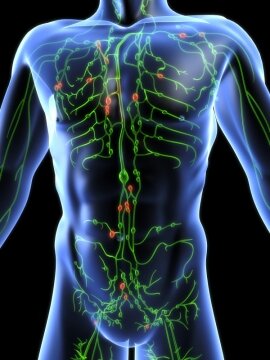

Non-Hodgkin's lymphoma is a type of cancer of the white blood cells (lymphocytes) that circulate within the lymphatic system. It is very similar to leukaemia which is a cancer of the white blood cells in the blood system.
NHL is a complex disease that is comprised of more than 80 different types of lymphoma. Click on the classification on the TYPES menu above to see all the types of NHL. Lymphoma primarily affects the lymph nodes, and bone marrow, but it can affect the major organs as well. In fact since your lymphatic system circulates to all parts of the body, there is virtually no place where that cannot be affected by lymphoma. One thing that is different about NHL from other types of cancer is that it does not dramatically alter the prognosis when the lymphoma spreads to other organs or body parts. The treatment is generally effective no matter where it has spread. Click on the image below to see a diagram of the structure of a lymph node.
The diagram below gives a great overview of where lymph nodes appear in the body. But for more detailed pictures of where lymph nodes appear, just click on the Lymph nodes option on the Lymphoma 101 menu item at the top.

There are over 80 different types of NHL, and while the treatment is often similar, in many cases the treatment is very unique for some types. This large variation in types of NHL makes it very difficult to diagnose in some cases. That wise old saying of get a second opinion takes on a whole new meaning. Your first step should be to get a second opinion from an experienced haematopathologist. Before you can begin any treatment plan you need to be confident of what you have first. It is the pathologists job to look at that biopsy specimen and determine what it is. Once the diagnosis is confirmed, then you want to have two or more opinions from expert haematologists or oncologists with a lot of experience in treating NHL, and get their treatment recommendation.
This is a description of how far the NHL has spread. NHL as you are likely learning is very different from most other cancers. Contrary to what you might be thinking, the stage is far less important for the low grade lymphomas than it is for most other cancers. Even with the aggressive lymphomas, the stage is only of moderate importance to the overall prognosis. Click here for more information about stage.
This category has two meanings. For lymphoma in general the grade means how fast is it growing. Low-Intermediate-High. Or in more common usage Indolent-Aggressive. (Intermediate is usually treated as aggressive). The second meaning of grade is for follicular lymphoma. It is a way of identifying just how slowly or quickly it can be expected to grow. Small cells grow very slowly. Large cells grow somewhat faster, therefore the fewer large cells you have the better your long term survival prospects. On the Grades page you can read more details about it, and see some slides showing what it looks like. Click here for more information about grades.
The causes of lymphoma are not clearly understood. Certain types of herbicides and pesticides are strongly believed to be a risk factor. Several viral infections are implicated in specific types of NHL as well, such as Epstein Barr Virus (Mononucleosis), and HTLV-1 virus (human T-cell lymphotrophic virus type I), Helicobacter pylori, and others. Having family members with lymphoma appears to increase the risk as well so this begs the question about if there is a genetic pre-disposition.
Please understand that you can't point your finger at one thing and say, "this caused my lymphoma" It is just not that simple. It takes multiple exposures to multiple risk factors to cause enough damage to a cell to make it mutate and become cancerous. At no point along the line can you say that a single thing pushed that damaged cell over the line.
Read the links below for more studies on thins that increase the risk of NHL.
Hepatitis C virus and risk of non-Hodgkin lymphoma in British Columbia, Canada
Agricultural pesticide use and risk of t(14;18)-defined subtypes of non-Hodgkin lymphoma
Family History of Hematopoietic Malignancy and Risk of Lymphoma
Familial predisposition and genetic risk factors for lymphoma.
A case–control study of non-Hodgkin lymphoma and exposure to pesticides
Click on the link below if you would like to see some biopsy slides of the various forms of NHL and normal lymph nodes/cells. While these slides are intended for medical professionals, you will find them quite fascinating to look at, and you may even begin to be understand them if you look at various different ones.
Lymphoma and other haematological pathology slides